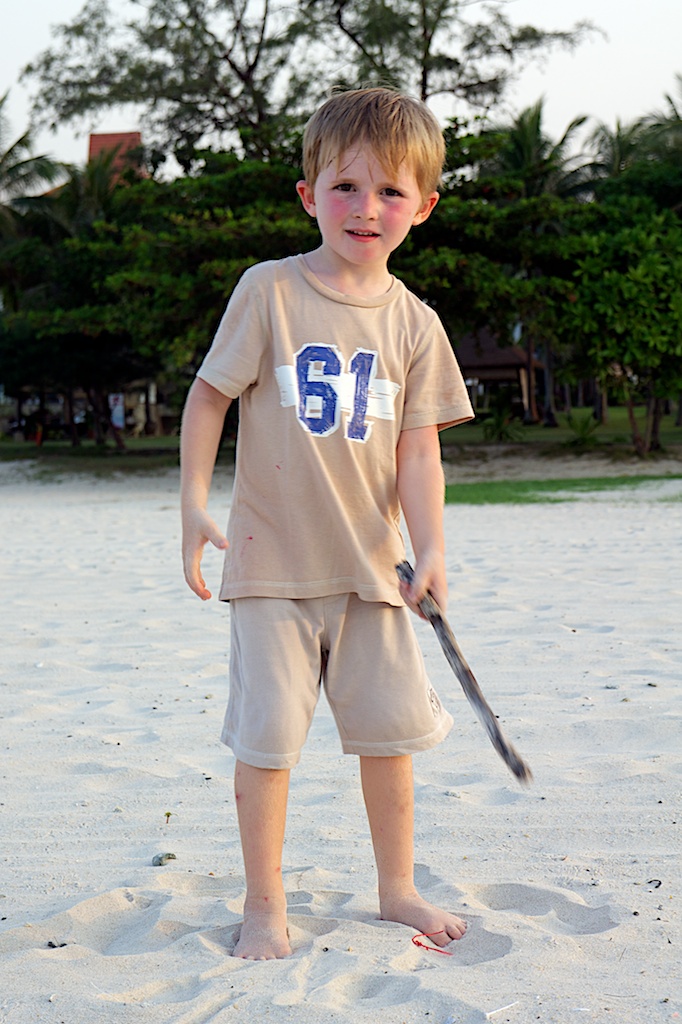To set up this exercise I needed a consistent setting and framing. I chose to photograph my son on the beach while we were on holiday. This meant the setting and composition were very similar; beach, foliage, sky in all frames. I was to shoot around twenty frames whilst concentrating on the facial expressions and changes in pose and gesture. My son is full of energy so to concentrate this he held and used a stick as a prop. This meant he could concentrate on something other than just me photographing him. In order to get me to concentrate on what I wanted from the shoot I needed to photograph the image sequence and then note what I felt, at the time, were my favourite shots from the sequence (without reviewing them). Then later on I downloaded them to my computer for a formal review of the sequence and ti grade them in to four categories; a) not good, b) acceptable, c) good, d) best single shot.
The sun was getting low in the sky, which made for soft light so my son didn’t need to squint in to the lens. At points I gave him direction and at points I just let him play depending on whether I thought I was getting the results I wanted.
My feelings while I was shooting were that, as I progressed through the shoot, the shots were getting closer to capturing what I wanted (character, personality) and that I was framing them better. My son also relaxed more in to the sequence and my ‘best single shot’ was one of the last shots. I realised that when he was throwing the stick from one hand to the other it may not come out so well as he had his eyes pointed downwards. I took two frames of him pointing the stick at me as I realised at the time that it was over his face in the first frame. As the shoot progressed I felt I was able to capture my son’s personality more accurately. This did mean, however, that he started to move around more which became more difficult to keep up with so some of the latter shots (him throwing the stick across his face) became unsatisfactory.
Here are the results and my comments on them. The images have not been edited except to give some contrast. I have not cropped them so I can assess whether the images I thought were good/bad at the time where just that.
Above is the gallery I deemed ‘not good’. It is a mixture of facial expressions not being what I wanted and also my son’s face being obscured in some way either from bending down or from the stick being in front of his face.
These are the images, which were ‘acceptable’. There some character involved in most of the shots and the expressions are interesting. The composition is also a little better in these images. Even if I am not seeing his face in these shots there is significant value to them to make them acceptable (to me).
These two images I felt were ‘good’. They express his character; his head is at a quizzical angle and his body language is playful as is his expression. The light also falls softly and evenly on his face. The background is more blurred having opened up the aperture, which focuses the attention more on the subject.
This is my ‘best single shot’. I seem to have his full attention with his eyes while his hands and arms continue to move and play. His body is still poised to move; yet his head and eyes are focused on the camera. It is a fleeting moment not to be repeated as within a split second he was off and running again.
This was just about he last shot of the sequence as he started to lose interest and I started to lose the light. This final favourite shot was the one that, at the time of shooting, I knew was a ‘keeper’. He was very clear in frame and when I pressed the shutter I knew without review that I would like it. This probably comes about from me knowing my son’s expressions and body language very well. It is likely that I pressed the shutter without thinking too hard about it, yet instinctively knew it would be worth taking (rather than just hoping). This has to be the aim when taking set up yet relatively candid portraits like this. Being able to ‘see’ the moment and capture it.

Great project – some lovely images. I liked some of the images where there was more interaction between subject and prop – drawing in the sand for example – in my view it tells a better story. I don’t think eye contact is always important. Goes to show that best images are often very subjective.